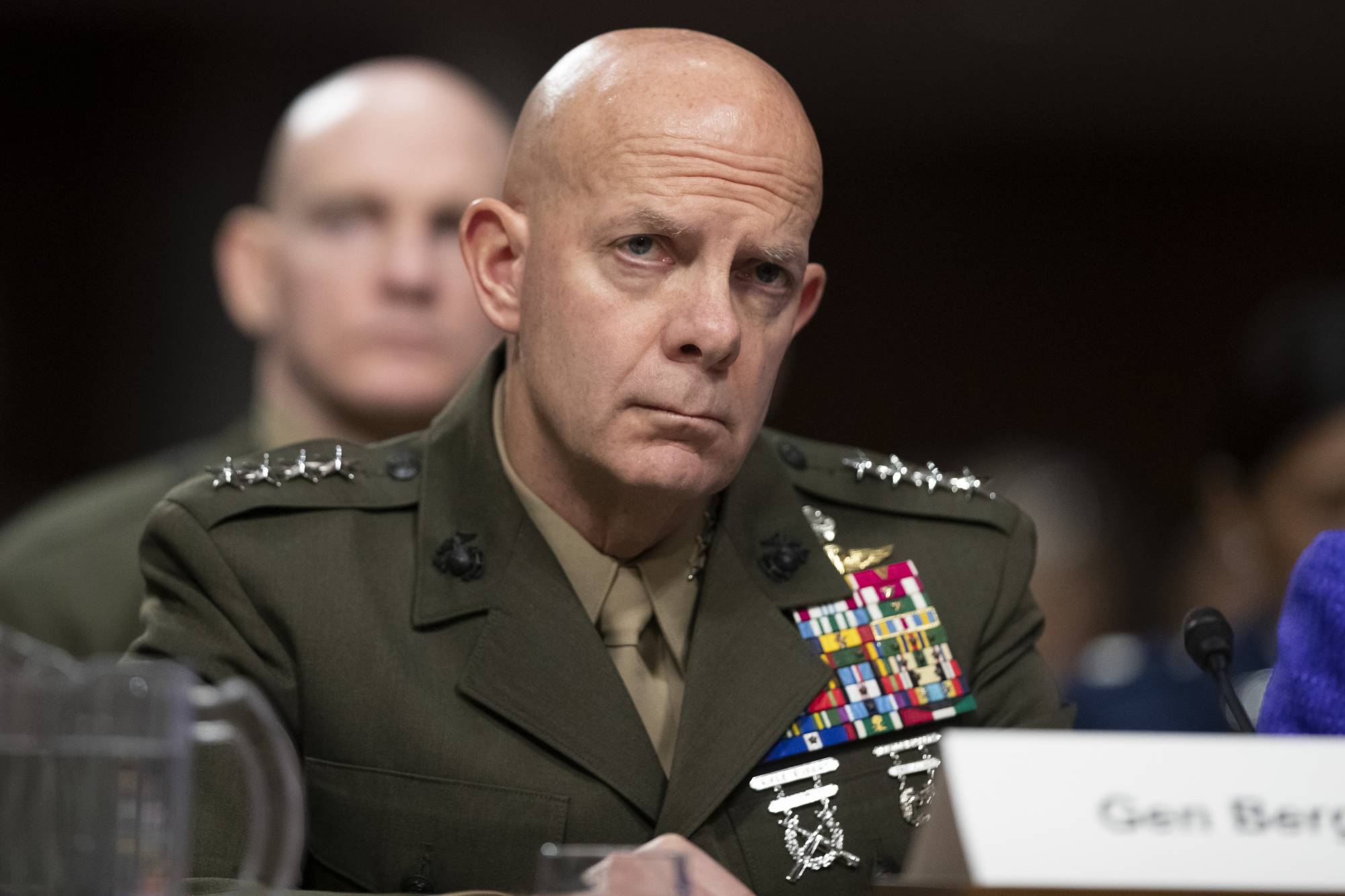
Why the Marine Corps has established its own software factory
If it's true that software is eating the world, that's certainly true of the U.S. military. One way to get crucial software is to develop it with your own people.
If it’s true that software is eating the world, that’s certainly true of the U.S. military. One way to get crucial software is to develop it with your own people. Now the Marine Corps is the latest component to establish a software factory for, in the Corps’ words, “solving real Marine problem sets.” For more, the Federal Drive with Tom Temin spoke with the software factory director, Lt. Col. Charlie Bahk.
Interview transcript:
Tom Temin And what’s the basic reason that the Marine Corps is establishing a software factory?
Charlie Bahk We all know that the future battlefield will be highly, highly lethal, technically disruptive, disconnected and just very ambiguous. So one of the things that we have learned over the years, and there’s no shortage of strategic level guidance, documents, policy and things of that nature that compels each of the services to have somewhat of an organic or modernized software delivery mechanism. And we’re kind of seeing this in the real world right now where we’re taking notes from the rest of the Ukrainian conflict, where the Ukrainian software warrior Brigade has provided a decisive tactical advantage for them by being able to conscript about 300,000 software developers. That capability out on to the front line, like the battlefield, is a tremendous capability to that commander to be able to bridge the gap between what he currently has, and being able to negotiate the problem that he doesn’t even know currently exists. So there’s that ambiguity part, like we need to be able to address that in a very rapid and agile manner.
Tom Temin So the standard way of hiring a contractor, setting up requirements and then hoping the software that gets delivered in two years is what you need, just doesn’t cut it in this environment.
Charlie Bahk I don’t believe so. And you’re absolutely correct. So this meshes very well with our commandant’s force design 2030 concept with standing forces and being able to persist inside the weapons engagement zone. We’re already there, and we are in competition with our adversaries and our reliance on contracted labor and in order to be able to negotiate that dynamic is not tenable. It is much better to grow this organic capability. And being able to work side by side in a complementary and supplementary manner with acquisition to be able to deliver software in a modernized fashion is the direction where we need to go.
Tom Temin Now, the Marine Corps factory is co-located and actually inter operates with the Army’s software factory. Tell us the thinking behind that strategy.
Charlie Bahk Yeah. So when General Milley, the chairman of the Joint Chiefs, a couple of years ago, went down to actually cut the ribbon on the facility I visited a couple weeks later, and I immediately knew that this is a capability that the Marine Corps needs as well. Except in a very resource constrained environment, the best way in order for us to operationalize this capability and the quickest is just to leverage what the Army has already invested in. I firmly believe that this is the right model where they are upskilling and enabling their organic force and training them up in this discipline. They have invested a tremendous amount of resources into this capability. What we have established, in terms of a formal agreement with them on, is to be able to just leverage their facilities that they’ve already brokered, as well as the production resources that they already have online.
Tom Temin And do you think that this will help in interoperability, because no military leader ever says a paragraph without the word joint in it. And there’s the [Joint All-Domain Command and Control (JADC2)] effort and all of these efforts to make sure that the forces can operate jointly. And that comes down in large measure to software interoperability.
Charlie Bahk Absolutely. There’s national collaboration and overlap. As a matter of fact, when the first cohort of Sixth Marines arrived in Austin, they will be integrating in with the Army software factory. We actually have a footprint on their production floor side by side with the soldiers, and there will be natural collaboration and overlap there.
Tom Temin And I guess you implied this, but the staffing of the software factory will be entirely uniforms. Will there be Marine Corps civilians there? And will there be any contractors as part of this?
Charlie Bahk So the first cohort is six active duty uniform. We have a tremendous partnership with our reserve component over at the the Marine Innovation Unit, where we’re able to leverage reserve talent. In the out years, as we are able to arrange for civilian force structure, we hope to get some GS representation as well. And then lastly, you asked about contractors, what we’re doing is that we are utilizing contracted labor during one of our pairing phases where we are utilizing those contractors as an accelerant to training the trainer. So basically getting the Marines upskilled, and senior enough to where we can turn around and start training the junior guys coming in.
Tom Temin We’re speaking with Lt. Col. Charlie Bahk. He is director of the Marine Corps Software Factory. Marines do a lot of things and some fire mortars, some fly helicopters, and some will be coding. Tapping at a keyboard. Is the kind of cultural diversion among those types of roles pretty much diminished nowadays?
Charlie Bahk So it’s meant to enforce it. What we are seeing in this new generation of Marines, there are digital natives. What we’re doing is we’re leveraging that new generation and their latent skill sets. These Marines are incredibly talented Marines. They’re multifaceted, they’re so skilled in so many different ways that we didn’t even think that they were trained to. But what we’re trying to do, is we’re trying to provide them with an opportunity to pursue the work that they’re truly passionate about. We are seeing that the Army’s Software Factory is leveraging soldiers from all across different [Military Occupational Specialty (MOS’)], infantrymen, engineers, logisticians. They are heroes by day, and then at night they’re pursuing software development in the barracks room. So we’re seeing that on the Marine Corps side. We’ve learned that through a series of innovation challenges that we have brought online. And what we have is that the talent exists out there. And what we’re trying to do is provide them with an opportunity to pursue software development, like the work that they actually care about. And there’s goodness in that. What I want to point out is that we’re able to leverage Marine Corps, we want to be able to leverage Marines from all different ranks and different backgrounds, because that diversity and the operational experience that they bring to the table, enriches solutions development. Which in term, provides a more capable body of product to the tactical edge.
Tom Temin Now, in the opening, we talked about solving real marine problem sets. Do you have a set of particular functions or software applications you have in mind to initially put through the factory?
Charlie Bahk Yeah. So we’re in the Marine Corps, everything is about war fighting. I need to be very clear about that, everything’s about war fighting. Whatever we can do to provide the commander with the decision making tools necessary to pull his decision making cycle to the left as far as possible, allowing him to ingest curated and conditioned data and information faster than the adversary is where we want to go. So we have an example already where we have developed a real world problem that supports our reconnaissance and counter reconnaissance problems. We frame that problem, designed and delivered that solution within 90 days. And then the succeeding 30, we gained fleet wide adoption where this application is now being used by intelligence units across the Marine Corps. And it’s gained such popularity that now the acquisition community is talking about bringing it up to a POR level, Program Of Record level and utilizing it as an enterprise level asset. So that is a success story that highlights so many different things as to why we’re standing up the Marine Corps Software Factory. We are taking organic, operationally experienced Marines to intimately understand problem sets, rapidly develop that solution, deliver it, and then if necessary, if it needs to get up to the enterprise level, if it deserves the rigor and the resourcing that acquisition can only provide, then we can transition that up to that level. So we are able to highlight wins across the entire spectrum with that one story.
Tom Temin In other words, there are certain, I guess, hurdles that a program would have to get over to become a program of record, and have the magical [Authorize to Operate (ATO)] at the enterprise level.
Charlie Bahk Correct. We would like to be able to deliver solutions, almost as a service construct, meaning that the warfighter doesn’t have to do any of that legwork, ideally we would love to be able to deliver that product as a package with a bow on it with the ATO and the whole nine.
Tom Temin And I guess that kind of implies the answer to my final question, and that is this is a three year pilot. How will you know when it’s ready to be made permanent, when it’s a success?
Charlie Bahk Yeah. Great questions. Yeah. So the the reason why we’re doing this pilot, is we need to evaluate the demand signal empirically from across the fleet marine force, during within the pilot we have a lot of work to get after and we have a lot of things to learn that we want to learn about. Can we turn this into a sustainable career path? Does is truly mesh with the management and talent retention model that we’re trying to get after in a very modernized fashion. What is the proper mix between active duty and reserve component Marines, civilian Marines and staff levels to truly deliver an optimized capability to the force?
Copyright © 2025 Federal News Network. All rights reserved. This website is not intended for users located within the European Economic Area.
Tom Temin is host of the Federal Drive and has been providing insight on federal technology and management issues for more than 30 years.
Follow @tteminWFED






